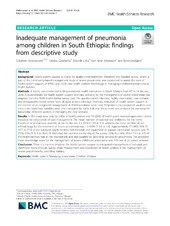| dc.contributor.author | Hailemariam, Solomon | en_US |
| dc.contributor.author | Gebeyehu, Yibibal | en_US |
| dc.contributor.author | Loha, Eskindir | en_US |
| dc.contributor.author | Johansson, Kjell Arne | en_US |
| dc.contributor.author | Lindtjorn, Bernt | en_US |
| dc.date.accessioned | 2020-05-12T13:25:51Z | |
| dc.date.available | 2020-05-12T13:25:51Z | |
| dc.date.issued | 2019-06-26 | |
| dc.Published | Hailemariam S, Gebeyehu, Loha E, Johansson KA, Lindtjorn B. among children in South Ethiopia: findings from descriptive study. BMC Health Services Research. 2019;19(426). | eng |
| dc.identifier.issn | 1472-6963 | |
| dc.identifier.uri | https://hdl.handle.net/1956/22206 | |
| dc.description.abstract | Background: Health system support is crucial for quality child healthcare. Therefore, this baseline survey, which is part of the community-based management study of severe pneumonia, was conducted to assess the state of health system support of IMNCI and iCCM, and health workers’ knowledge in managing childhood pneumonia at health facilities. Methods: A survey was conducted in 99 government health institutions in South Ethiopia from 07 to 14 January, 2018. A questionnaire for health system support and case scenario for the management of severe pneumonia was adapted from the WHO health facility survey tool. The questionnaire’s interview, facility observation, case scenario and retrospective record review were all used as data collection methods. Indicators of health system support in the context of an integrated management of childhood illness were used. Proportions for categorical variables and means for continuous variables were also computed for each indicator. Mean score was analysed for assessing the knowledge of health workers in managing the case scenario. Results: In the study area, only 12 (34%) of health centres and 18 (29%) of health posts received supervision, which included the observation of case management. The mean number of essential oral antibiotics for the home treatment of pneumonia available at the facility was 1.1 (95% CI 0.9 to 1.3), whereas the mean number of pre- referral drugs for the treatment of severe pneumonia was 1.3 (95% CI 1.0 to 1.6). Approximately 47 (48%; 95% CI 37.7 to 57.3) of the surveyed health facilities had materials and equipment to support vaccination services, and 71 (72%; 95% CI 62.8 to 80.6) of them had the vaccines on the day of the survey. Only four (4%; 95% CI 0.3 to 8.3) of the health facilities had all the essential job aids and supplies for providing services for pneumonia. The providers’ mean knowledge score for the management of severe childhood pneumonia was 14.9 out of 22 correct answers. Conclusion: There is a room to improve the health system support to integrated management of neonatal and childhood illness through supply chain management and knowledge of health workers in the management of severe pneumonia by providing training. Keywords: Health system, Managing pneumonia, Children, Ethiopia | en_US |
| dc.language.iso | eng | eng |
| dc.publisher | BMC | eng |
| dc.relation.uri | https://doi.org/10.1186/s12913-019-4242-7 | |
| dc.rights | Attribution CC BY | eng |
| dc.rights.uri | http://creativecommons.org/licenses/by/4.0/ | eng |
| dc.subject | Health system | eng |
| dc.subject | Managing pneumonia | eng |
| dc.subject | Children | eng |
| dc.subject | Ethiopia | eng |
| dc.title | Inadequate management of pneumonia among children in South Ethiopia : findingsfrom descriptive study | en_US |
| dc.type | Peer reviewed | |
| dc.type | Journal article | |
| dc.date.updated | 2020-01-10T14:56:01Z | |
| dc.description.version | publishedVersion | en_US |
| dc.rights.holder | Copyright 2019 The Authors | |
| dc.identifier.doi | https://doi.org/10.1186/s12913-019-4242-7 | |
| dc.identifier.cristin | 1768468 | |
| dc.source.journal | BMC Health Services Research | |
| dc.relation.project | NORHED: etH-13/0025 | |

